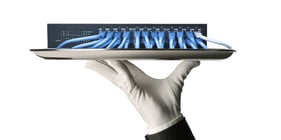 Your core network is the digital backbone of your entire organization. It’s responsible for facilitating essential functions like communication, billing, customer service and data storage.
Your core network is the digital backbone of your entire organization. It’s responsible for facilitating essential functions like communication, billing, customer service and data storage.
There is a lot of pressure riding on your network and, over the next few years, you will in all likelihood continue to trust your network with more tasks by investing in new technologies like Power over Ethernet and the Internet of Things.
As the reliance on your core network grows, it will be increasingly important to ensure its stability. System downtime, for instance, can cost up to $300,000 per hour. You can anticipate that the cost of network downtime will increase with each critical task that you trust your network to complete. Therefore, it’s imperative that you gain the ability to keep your network healthy and avoid downtime at all costs; and if downtime should happen, you need the ability to figure out the root cause and fix the problem as soon as possible. This process needs to happen immediately—not over the course of several hours or days.
The idea of Total Network Visibility is the core principle behind our TotalView line of network monitoring platforms. TotalView 6 is our latest and most advanced solution to date, going beyond network visibility by providing greater depth and intelligence for identifying and solving problems. Just like its predecessor, the 2014 InfoWorld Product of the Year TotalView 5, TotalView 6 is built with ultra-lightweight code that allows for real-time network scanning. It’s faster, more customizable and more comprehensive than any other solution available on the market.
It should also be noted that TotalView can be easily installed and up and running in about 12 minutes—meaning there is no excessive wait time in regard to installation, as opposed to other solutions which can be a lengthy process to set up and deploy.
Here are some of the features that TotalView 6 offers:
Network mapping: TotalView 6 enables you to view the overall status and health of every single link and device that connects to the core network, as well as the status of the core network as a whole, using the new and improved Dynamic Network Map feature.
One of the most exciting new features about TotalView 6 is the flexibility of the Dynamic Network Map. While TotalView 5 offered a basic view of the central network, any number of individual maps can be created using TotalView 6. So if your business has multiple network locations, you can watch over all of them from a central browser.
The Dynamic Network Map also offers a wider view of the surrounding region. If a key Internet link fails in the surrounding area, it can be reported to customers before they call in and complain. This information also provides customer service agents with an informed response when customers do dial in with questions about why the network is down. Of course, the Dynamic Network Map includes all of TotalView 5’s functionality: it’s easy to read, and comes with a variety of useful alerts for informing team members about network usage or Internet outages. For example, a Web link will appear as a thin green line if there is not much traffic utilizing the network, and it will become thicker as more traffic is sent over it. If a link goes down, the line will turn black. The map also contains audio alerts that will sound in order to make sure that team members are alerted about system errors. This is a boon for data center professionals who can be made instantly aware of problems in the network instead of receiving cryptic “Interface Fe0/9 changed status to down” messages that arrive minutes after the outage occurred.
The Dynamic Network Map is hardware-agnostic, that is, it can be conveniently viewed on any device using a Web browser.
Advanced inventory management: It’s just about impossible to monitor the stability of your network without first knowing which devices are powering it (like switches, routers, and servers). TotalView 6 makes this process easy with a revamped, automated inventory management system capable of tracking more inventory than any other product, including:
- Type of device
- OS version
- Manufacturer
- Manufacture date
- Type of firmware
- Serial number
- Software revisions
- Cisco Discovery Protocol (CDP)
- Link Layer Discovery Protocol (LLDP)
You will also love TotalView 6’s financial tracking, which can be used to track equipment costs, depreciations and also help adhere to compliance requirements.
Call quality analysis: There are a lot of VoIP troubleshooting solutions available on the market, but the majority of these fail to take network health into account and simply provide a high- level solution—often they can only confirm that a problem exists and not really help find the root-cause location or fault of a detected problem. They simply tell you that you have a problem with your VoIP system but they don’t tell you what’s causing it. TotalView 6, however, ensures VoIP stability by providing advanced network information via its built-in Call Simulator.
The Call Simulator can help determine lost Differentiated Services Code Points (DSCP). It can also automatically register remote agents on the network.
According to PathSolutions’ CTO Tim Titus, TotalView 6 also solves what can only be described as the “Yoda Conundrum”: when packets arrive out of order on a VoIP call.
“Data needs to arrive in order when using VoIP,” he said during a recent interview. “If data packets start to arrive out of order during a VoIP call, this is a big problem. It’s similar to having a conversation with Yoda – everything is backwards and scrambled.”
In other words, missing or delayed packets can cause words and phrases to arrive at different times—making conversation all but impossible to understand. If packets begin to arrive out of order during a call, TotalView 6 can determine where and when the issue originated, so that the problem can be tracked down and fixed.
Network Health tab: The Network Health tab was completely redesigned to be more user-friendly and intuitive in TotalView 6.
The new Network Health tab is a drag-and-drop style interface, meaning you can add widgets as needed. These widgets can be moved outside of the browser window, too. You decide which metrics need extra tracking, and TotalView will automatically update the information as it comes in.
Compliance and finance tracking: Chances are likely your industry has stringent requirements for ensuring that the network devices you are using are up to date with the latest standards and software versions. This is very hard to ensure, however, when considering the size and speed with which networks often grow. The last thing you want to discover during an audit is that some of your network equipment is several years old and is vulnerable to security holes. For instance, you may have sensitive information stored on a server that is in dire need of patching. It’s important to discover these issues so that you can ensure your network is in optimal condition at all times.
TotalView 6 makes it easy to stay in compliance with IT regulations by providing compliance information for network equipment.
TotalView 6 also helps networks monitor network costs by aggregating cost and amortization data for each connected device. This feature can help IT professionals gain a better idea of which devices are the most expensive to operate. Let TotalView 6 be your information repository for procurement costs, annual support costs and usage information for network devices. The software can even provide the cost per gigabit of each WAN link. This data is of great benefit when weighing capital and operational expenses of existing equipment versus new solutions.
Are you ready to see your network in a whole new light? Learn more about TotalView 6.







